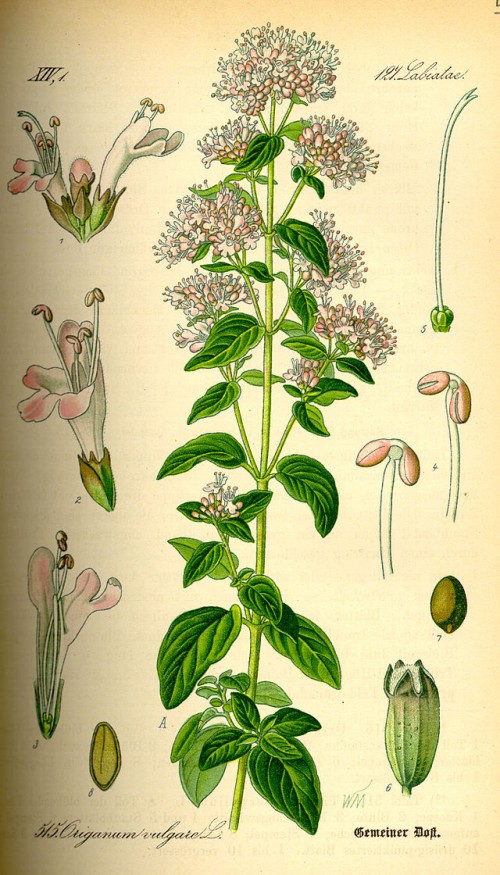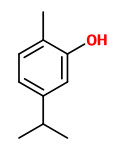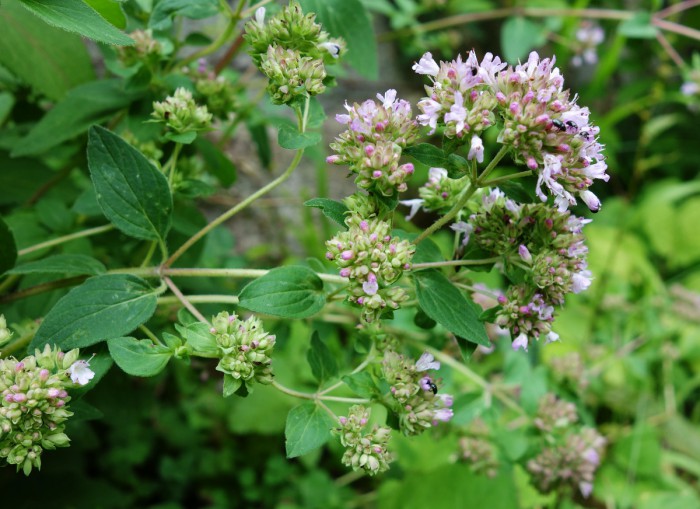Dies ist eine alte Version des Dokuments!
Origanum vulgare L. - Lamiaceae - oregano, wild marjoram, pot marjoram, Gemeiner Dost, Oregano
Perennial herb, native from Europe to Central Asia; 20-70 cm tall; leaves opposite, 1-4 cm long. There are several subspecies and cultivars.
http://de.wikipedia.org/wiki/Oregano#Systematik
http://www.ars-grin.gov/cgi-bin/npgs/html/taxon.pl?25913
Origanum vulgare subsp. hirtum (Link) Ietsw. (syn. Majorana neglecta (Vogel) Walp., Origanum heracleoticum Benth.: „A high carvacrol content in essential oil is the key to the concept of the ‘oregano’ spice and is a prerequisite determining a plant's suitability for the preparation of this condiment. Origanum heracleoticum L., the main source of Greek oregano, is a chemically non-uniform species. Within its wild population there are at least three chemo-varieties which, although similar in their external appearance, differ in their odours. On the basis of their flavours and essential oil compositions, these varieties could be defined as marjoram, thyme and oregano-types. The latter, which contains mainly carvacrol, is traditionally, and almost exclusively, collected for oregano spice preparation on the basis of its odour.“
[Oregano spices and Origanum chemotypes. Fleisher, A. and Sneer, N. (1982), J. Sci. Food Agric., 33: 441–446]
„The plants of wild Origanum vulgare L. ssp. vulgare were collected in 10 localities of Vilnius district (Lithuania) in 1995-1999. The main constituents of the essential oils from 8 localities were β-ocimene (14.9-21.6%), germacrene D (10.0-16.2), β-caryophyllene (10.8-15.7%) and sabinene (6.6-4.2%). The essential oils from two localities contained only three above compounds as major components: germacrene D, β-ocimene and sabinene or β-caryophyllene, beta-ocimene and germacrene D. Three chemotypes of essential oils were identified. The main chemotype was β-ocimene germacrene D-β-caryophyllene. The terpenic hydrocarbons made up 52.8-80.6% of the essential oils. The 42 identified components made up 85.6-98.0% of the essential oil.“
[The essential oil of Origanum vulgare L. ssp. vulgare growing wild in vilnius district (Lithuania). Mockute D1, Bernotiene G, Judzentiene A., Phytochemistry, Vol.57(1), 2001, 65-9]
„When the essential oil of oregano was analyzed by GC-MS 32 compounds were identified, representing 88.5% of the total oil, the major constituent being carvacrol (61.21%). Other important compounds were p-cymene (15.12%) and γ-terpinene (4.80%). Sezik et al. investigated the essential oil composition of four subspecies of Origanum vulgare, subsp. hirtum (Link) Ietswaart, subsp. gracile (C. Koch) Ietswaart, subsp. vulgare and subsp. viride (Boiss.) Hayek, all of which grow wild in Turkey, and identified more than 80 constituents. Origanum vulgare subsp. hirtum was rich in carvacrol (70.47%), while subsp. gracile contained β-caryophyllene (17.54%) and germacrene-D (12.75%) as dominant components. The major components of subsp. viride were terpinen-4-ol (16.82%) and germacrene-D (15.87%) and of subsp. vulgare terpinen-4-ol + β-caryophyllene (20.94%) and germacrene-D (17.80%).“
[Chemical Composition of the Essential Oils Obtained From Some Spices Widely Used in Mediterranean Region. Manuel Viuda-Martos, Yolanda Ruíz-Navajas, Juana Fernández-López, José Angel Pérez-Álvarez, Acta Chim. Slov. 921 2007, 54, 921–926]
Oregano species growing in Argentina do not own significant concentrations of
carvacrol. Major compounds found were the monoterpenes γ-terpinene (32.1%), α-terpinene (15.1%), p-cymene
(8.0%), thymol (8.0%) and β-phellandrene (7.1%).
[Chemical composition, antioxidant activity and anti‐lipase activity of Origanum vulgare and Lippia turbinata essential oils., Quiroga, P.R., Grosso, N.R., Lante, A., Lomolino, G., Zygadlo, J.A., Nepote, V., International Journal of Food Science & Technology, 48(3), 2013, 642-649]
„The major components of oregano essential oil were carvacrol, β-fenchyl alcohol, thymol, and γ-terpinene. Hot water extract had the strongest antioxidant properties and the highest phenolic content.“
[Chemical composition and bioactivity of different oregano (Origanum vulgare) extracts and essential oil. Teixeira, B., Marques, A., Ramos, C., Serrano, C., Matos, O., Neng, N. R., Nogueira, J. M. F., Saraiva, J. A. and Nunes, M. L. (2013), J. Sci. Food Agric., 93: 2707–2714]
A high content of carvacrol and thymol is responsible for the antifungal activity against the human pathogens
Malassezia furfur, Trichophyton rubrum, and Trichosporon beigelii.
[Antifungal activities of Origanum vulgare subsp. hirtum, Mentha spicata, Lavandula angustifolia, and Salvia fruticosa essential oils against human pathogenic fungi., Adam, K., Sivropoulou, A., Kokkini, S., Lanaras, T., Arsenakis, M., Journal of Agricultural and Food Chemistry, 46(5), 1998, 1739-1745]
The main compounds of the hydrodistilled essential oil were 4-terpineol (47.9%), carvacrol (9.4%), thymol (8.4%) and α-terpineol (7.5%).
„Candida albicans isolates from animal mucous membranes exhibited MIC and MFC values of 2.72 µL mL-1 and 5 µL mL-1, respectively. MIC and MFC values for C. albicans standard strains were 2.97 µL mL-1 and 3.54 µL mL-1, respectively. The MIC and MFC for non-albicans species were 2.10 µL mL-1 and 2.97 µL mL-1, respectively. The antifungal activity of O. vulgare essential oil against Candida spp. observed in vitro suggests its administration may represent an alternative treatment for candidiasis.“
[In vitro activity of Origanum vulgare essential oil against Candida species., Cleff, M.B., Meinerz, A.R., Xavier, M., Schuch, L.F., Meireles, M.C.A., Rodrigues, M.R.A., Mello, J.R.B.D., Brazilian Journal of Microbiology, 41(1), 2010, 116-123] http://www.scielo.br/pdf/bjm/v41n1/v41n1a18.pdf

Thomé,O.W., Flora von Deutschland Österreich und der Schweiz, Tafeln, vol.4 t.515 (1885)
http://plantgenera.org/species.php?id_species=724561


